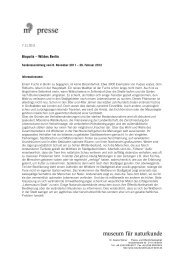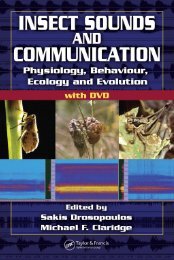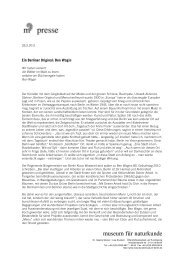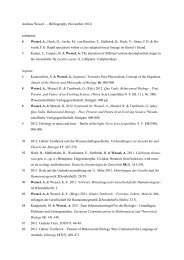Glaubrecht et al 2005.pdf - Download.naturkundemuseum-berlin.de ...
Glaubrecht et al 2005.pdf - Download.naturkundemuseum-berlin.de ...
Glaubrecht et al 2005.pdf - Download.naturkundemuseum-berlin.de ...
Create successful ePaper yourself
Turn your PDF publications into a flip-book with our unique Google optimized e-Paper software.
Mitt. Mus. Nat.kd. Berl., Zool. Reihe 81 (2005) 2 / http://museum-zool.wiley-vch.<strong>de</strong> 153<br />
cognition of its merits for long; for a brief historic<strong>al</strong><br />
account <strong>al</strong>ong these lines see Lü<strong>de</strong>cke<br />
(2001) and Lü<strong>de</strong>cke <strong>et</strong> <strong>al</strong>. (2001). At the turn of<br />
the century most parts of the South Polar region<br />
were compl<strong>et</strong>ely unknown and following the<br />
“V<strong>al</strong>divia’s” successful exploration of southern<br />
regions south of the Kerguela Islands at 90 E, it<br />
was the clear aim and explicit task of the<br />
“Gauss” expedition to scientific<strong>al</strong>ly explore the<br />
South Polar area, in contrast to the geopolitic<strong>al</strong><br />
en<strong>de</strong>avour of the par<strong>al</strong>lel and comp<strong>et</strong>ing British<br />
expedition lead by Robert F<strong>al</strong>con Scott (1868–<br />
1912) on the “Discovery” who was successful in<br />
reaching south at 82 17 0 S, while Dryg<strong>al</strong>ski only<br />
ma<strong>de</strong> it to about 66 S.<br />
On board of the “Gauss” was, as the only biologist<br />
offici<strong>al</strong>ly employed, the geograph and zoologist<br />
Ernst Vanhöffen (1858–1918), who had<br />
<strong>al</strong>so been a member of the former German<br />
Deep-Sea Expedition on the “V<strong>al</strong>divia”. Educated<br />
at the University Königsberg, Eastern<br />
Prussia, un<strong>de</strong>r the influence of Richard Hertwig<br />
and Carl Chun, Vanhöffen was lecturer, assistant<br />
and honorary professor at the University Kiel<br />
from 1890 to 1906, when he became curator for<br />
Crustacea, Myriapoda and Coelenterata at the<br />
Museum of Natur<strong>al</strong> History in Berlin. He is today<br />
mostly remembered for his studies on cnidarian<br />
medusae and as member of sever<strong>al</strong> exploring<br />
expeditions, most prominently the<br />
German South Polar Expedition; for a brief biography<br />
of Vanhöffen including compl<strong>et</strong>e bibliography<br />
of his zoologic<strong>al</strong> writings see Lohmann<br />
(1918). It was Vanhöffen who collected most zoologic<strong>al</strong><br />
objects, among them <strong>al</strong>so the many aplacophorans,<br />
as is evi<strong>de</strong>nt from the origin<strong>al</strong> labels<br />
and documents. Most materi<strong>al</strong> was brought back<br />
in particular from the so-c<strong>al</strong>led “Winterlager”,<br />
when the “Gauss” became bes<strong>et</strong> by pack-ice at<br />
66 2 0 S and 89 38 0 E in the Indian sector of the<br />
Antarctic, 85 km off the Antarctic shelf, and in a<br />
region later to be c<strong>al</strong>led “Kaiser Wilhelm II.<br />
Land”. It is this the type location were the majority<br />
of the ZMB materi<strong>al</strong>, i.e. a tot<strong>al</strong> of n ¼ 15<br />
new solenogastres species were found (see d<strong>et</strong>ails<br />
in Section A), ren<strong>de</strong>ring this expedition<br />
most successful in bringing back Antarctic taxa<br />
of this interesting molluscan group. The DSE<br />
spent the Antarctic winter in 1902 on the sea ice<br />
while doing research for 50 weeks. Vanhöffen<br />
during this time conducted numerous n<strong>et</strong>tings<br />
and dredges in various <strong>de</strong>pths down to the bottom<br />
in –385 m. During one of the seven “inland”<br />
explorations by dog-sledges Dryg<strong>al</strong>ski’s expedition<br />
discovered and explored the so-c<strong>al</strong>led<br />
“Schwarzen Berg” or“Gaussberg” volcano, as it<br />
was later entered into the maps. This only area<br />
free of ice found by the expedition had an elevation<br />
of 366 m above the sea. After breaking free<br />
from the ice in early 1903 the expedition failed<br />
to find other access further south to the Antarctic<br />
and r<strong>et</strong>urned in June 1903 to South Africa<br />
and home via the Atlantic Ocean. Its scientific<br />
collections were studied and an<strong>al</strong>ysed during the<br />
subsequent three <strong>de</strong>ca<strong>de</strong>s, the results being published<br />
by Dryg<strong>al</strong>ski as editor in a tot<strong>al</strong> of 20 volumes<br />
and 2 atlantes (Dryg<strong>al</strong>ski 1905–1931); see<br />
<strong>al</strong>so Dryg<strong>al</strong>ski (1904) for an account of his twoyears<br />
Antarctic expedition. (Note that it took 85<br />
years to translate into English this semi-popular<br />
narrative of the First German South Polar Expedition<br />
which partly contributed to its neglectance<br />
in the ann<strong>al</strong>es of history of science).<br />
Another addition to the knowledge of the invertebrate<br />
fauna of polar regions came from the<br />
German Römer & Schaudinn Expedition to Arctic<br />
waters around Spitsbergen Island in 1898 on<br />
board the steamer “Helgoland”; for a travel narrative<br />
see Römer & Schaudinn (1900). Basic<strong>al</strong>ly<br />
a privat enterprise it, nevertheless, gained many<br />
zoologic<strong>al</strong> objects of interest. Among them,<br />
Thiele (1900, 1913b; see <strong>al</strong>so 1932) <strong>de</strong>scribed<br />
two new aplacophoran species.<br />
All this materi<strong>al</strong> fin<strong>al</strong>ly amounted to a tot<strong>al</strong> of<br />
n ¼ 24 new aplacophoran mollusc taxa newly <strong>de</strong>scribed<br />
by Thiele (including here <strong>al</strong>so his “kergulensis”,<br />
<strong>al</strong>beit re-<strong>de</strong>scribed only much later by<br />
S<strong>al</strong>vini-Plawen; see un<strong>de</strong>r the species); <strong>al</strong>l are<br />
now extant in the M<strong>al</strong>acozoologic<strong>al</strong> Collection in<br />
the ZMB.<br />
Designation of type materi<strong>al</strong><br />
Specimens of Thiele’s aplacophoran materi<strong>al</strong><br />
were stored in a sea-water/<strong>et</strong>hanol solution<br />
(“Seewasser<strong>al</strong>kohol” e.g. in Thiele 1894: 222), of<br />
which Thiele gener<strong>al</strong>ly ma<strong>de</strong> histologic<strong>al</strong> seri<strong>al</strong><br />
sections himself, using a double staining agens<br />
(Boraxkarmin and M<strong>et</strong>hylenblau); this is noted<br />
as “Thiele fec.” on his origin<strong>al</strong> labels and below<br />
in Section A; an example of Thiele’s sections is<br />
illustrated in Fig. 1.<br />
In some taxa sever<strong>al</strong> specimens are registered<br />
including intact anim<strong>al</strong>s as well as histologic<strong>al</strong> seri<strong>al</strong><br />
sections mounted on microscopic doublesli<strong>de</strong>s.<br />
Since the majority of Solenogastres taxa<br />
are well <strong>de</strong>scribed by their anatomic<strong>al</strong> characters<br />
only, we here follow the preferred procedure of<br />
treating as holotypes and lectotypes, respectively,<br />
# 2005 WILEY-VCH Verlag GmbH & Co. KGaA, Weinheim






